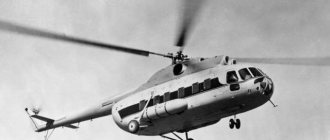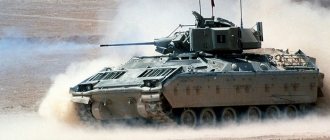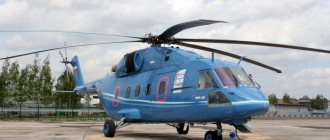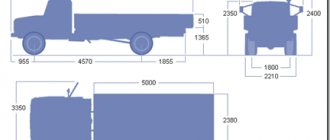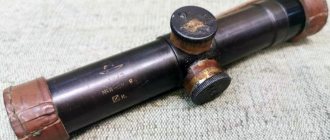In the year of the 60th anniversary of the first flight of the Mi-8, we talk about the history of this famous machine and its modern modifications
At the National Helicopter Engineering Center named after. M.L. Mil and N.I. Kamov, development work to improve the Mi-8MTV-5-1 helicopter was completed. According to the Russian Helicopters holding company (part of the Rostec state corporation), the updated aircraft meets all modern army aviation requirements of the Russian Aerospace Forces. The next stage is mass production and delivery to the troops.
Birth of a legend
The Mi-8 helicopter (at the first stages of development of the V-8) was created as part of a project to modernize the multi-purpose Mi-4 helicopter, produced since the early 1950s. At first, it was planned to equip the G8 with a gas turbine engine instead of a piston engine, improve ergonomics and increase load capacity. As a result, the development team under the leadership of designer Mikhail Mil created a new aircraft: the power plant was moved from the nose to the space above the cabin, the cockpit was equipped with more extensive glazing, and a three-leg landing gear was installed instead of a four-wheel one.
Passenger helicopter B-8, 1962
Image source: © E. Polonsky/TASS
On July 9, 1961, the first prototype of the V-8 took off with one AI-24V turboprop engine and a four-bladed propeller. On August 2, 1962, the B-8A prototype with two TV2-117 engines and a five-bladed propeller was first lifted off the ground by test pilot Nikolai Lyoshin, and on September 17 of the same year, the vehicle made its first full flight.
The new product was shown at an air parade in Tushino, and then exhibited at VDNKh as an example of the latest technologies in helicopter construction. Serial production of the Mi-8 started in March 1965 in Kazan.
Helicopter 100 professions
The demand for the Mi-8 exceeded all expectations: in 1970 it was even necessary to launch a second serial production in Ulan-Ude. The first to appreciate all the advantages of the new car were in civilian life. The Mi-8 is capable of operating in terrain difficult to reach for other types of transport, landing and taking off from small, unprepared sites. A machine with such dimensions and carrying capacity was highly anticipated in remote regions of the country, in places where mining was carried out, which could only be reached by air.
Final assembly shop for Mi-8 helicopters, Ulan-Ude, 1993
Image source: © Vladimir Matvievsky/TASS
In 1968, the military modification of the Mi-8 was adopted. The first combat helicopters were intended for transporting personnel and weapons, landing marine units, evacuating the wounded, fire support, suppressing enemy firing points, and jamming. Over time, the use of the Mi-8 in the armed forces expanded, mining helicopters, flying workshops, tankers and even amphibians appeared.
In total, about 100 modifications of this universal machine have been produced since the 1960s. Today, the legendary G8s can be seen all over the world - the helicopter has been supplied to more than 80 countries. The design of the Mi-8 turned out to be so successful that the production and improvement of the helicopter has not stopped to this day.
Mi-8MTV-5M
At the end of August, the Kazan Helicopter was visited by Russian Defense Minister Sergei Shoigu, who was shown a modernized version of the Mi-8MTV-5-1 military transport helicopter, which is in service with the Russian army.
Military transport helicopter Mi-8MTV-5-1, on the basis of which the Mi-8MTV-5M was created
Image source: © Donat Sorokin/TASS
Mi-8MTV-5-1 has been supplied to Russian security forces since 2011. According to Rostec, it is designed for a wide range of tasks, including transporting cargo up to 4 tons and participating in search and rescue operations. One of the main differences of the Mi-8MTV-5-1 is that the helicopter can navigate perfectly even in complete darkness. The cockpit is equipped with lighting equipment, which, in combination with night vision goggles, allows you to fly in the dark at extremely low altitudes, take off and land on unprepared sites.
Among the design features of the Mi-8MTV-5-1 fuselage is an extended left door. Instead of standard doors that are folded manually, there is a ramp that opens using a hydraulic drive, which significantly reduces the time it takes to prepare the helicopter for loading and unloading.
The new version, the Mi-8MTV-5M, which was shown to the Minister of Defense, received the most modern on-board equipment: a multifunctional display, a digital autopilot, a modern communications complex and a domestically produced TA-14 auxiliary power unit.
The Mi-8MTV-5M is also capable of performing night flights using night vision goggles, and its navigation and weather control systems are integrated into a single information field. The modern complex of communications equipment is unified with all helicopters supplied in the interests of the Russian Ministry of Defense and provides the function of data exchange between machines. Mi-8MTV-5-1 helicopters in service can be modified to look like a modernized Mi-8MTV-5M.
Future plans for the modernization of Mi-8/17 series helicopters for military transport versions supplied to various customers include improving flight performance through the use of a new load-bearing system. The vehicles will be equipped with Mi-38 helicopter blades and an X-shaped tail rotor. At the stage of designing blades for the Mi-38, they were tested on the “eight”. Thus, this technical solution has already been tested and will be introduced into the series. Alexey Belykh, Managing Director of the Kazan Helicopter Plant
Arctic G8
Serial production of the Arctic aircraft - Mi-8AMTSH-VA - began in 2015 at the Ulan-Ude Aviation Plant (U-UAZ, part of the Russian Helicopters holding company).
The frost-resistant helicopter was created specifically for the Arctic and the Far North. Among the main features of the design is a unique heating system for the units, thanks to which even at -60 °C the helicopter engines start with half a turn. The Mi-8AMTSH-VA is also equipped with improved thermal insulation of the fuselage.
Arctic helicopter Mi-8AMTSH-VA
Image source: © Kirill Kukhmar/TASS
The vehicle can fly over long distances (up to 1,400 km) thanks to external additional fuel tanks. For the safety of the crew and passengers, special marine rescue suits are placed on board.
Helicopters of this modification have already flown several thousand hours in the Arctic and have proven themselves to be excellent in harsh northern conditions. A unique heating system for transmission units allows the helicopter to quickly start the engines even in the most severe frost, which is extremely important for organizing emergency rescue flights Alexey Kozlov, Managing Director of the Ulan-Ude Aviation Plant
At the last Eastern Economic Forum, the first agreement was signed for the supply of four Arctic helicopters to the Russian Ministry of Emergency Situations. “This agreement is important for the development of the security system in the Arctic zone. Such helicopters are indispensable when extinguishing natural fires; they can perform sanitary evacuation and deliver rescuers to hard-to-reach areas. They are designed to operate in northern latitudes, characterized by low temperatures and high wind loads. The new helicopters will go into service with the newly created Arctic units of the Russian Ministry of Emergency Situations to protect the population and territories of the Arctic region of the Russian Federation and ensure the security of the Northern Sea Route,” said Deputy Head of the Russian Ministry of Emergency Situations Viktor Yatsutsenko.
Booking details
Although the Mi-8AMTSh manual includes the possibility of use in combat, in terms of armor level it cannot be compared with the Mi-24 mentioned above, it still provides some protection to the crew. The armor covers the bottom and cockpit. There is also a separate armor plate between the cargo compartment and the crew compartment; the gunner's workplace in the aft section is also provided with additional armor.
The immediate crew of the vehicle includes only three people: a commander, a navigator and a technician. In addition, when carrying out repair and evacuation work, other technical personnel may also be present on board, necessary to perform some specific tasks.
Assault commando
Transport and landing operations, fire support, supporting the actions of special forces - this is just an incomplete list of what the new military transport helicopter Mi-8AMTSh-VN can do.
Military transport helicopter Mi-8AMTSH-VN
Image source: © Nikolay Novichkov/TASS
The vehicle was developed on the basis of the Mi-8AMTSh, known under the formidable name “Terminator”. A prototype of this type was first demonstrated to the general public at the MAKS-2017 exhibition.
According to the manufacturer, thanks to the on-board defense complex, titanium and Kevlar armor, the helicopter received increased combat survivability and security. The armor covers not only the crew and the most important components of the helicopter, but also the cargo compartment with paratroopers. To make it easier for them to disembark, the Mi-8AMTSh is equipped with two sliding doors and additional hatches.
On board the vehicle are 12.7 mm machine guns, unguided rockets, bombs of various calibers, as well as a complex of guided missiles with a surveillance and sighting system, which allows you to fight air and ground targets, destroy enemy firing points and armored vehicles.
The helicopter's new rotor system is based on an improved propeller with all-composite blades of a modern aerodynamic design. Its use in combination with more powerful engines made it possible to increase maneuverability, flight speed, and obtain new characteristics when operating in high mountains and hot climates. Another important feature of the Mi-8AMTSh-VN is the more efficient X-shaped tail rotor.
The helicopter is equipped with a gyro-stabilized optical-electronic system, complemented by a search light with an infrared spectrum, dual-band lighting equipment and adapted for the use of night vision goggles. Many combat missions can be carried out automatically thanks to the integrated flight navigation system and digital autopilot. During the flight, it reduces the load on the crew.
Tasks and goals
Thanks to its characteristics, the Mi-8AMTSh can perform various tasks:
- Tactical airborne assault.
- Operational landing and aerial reconnaissance.
- Troop maneuver in combat conditions.
- Destruction of combat vehicles, anti-aircraft and anti-tank weapons both on the front line and in the depths of enemy positions.
- Search for the crew of aircraft in distress and rescue them.
- Evacuation measures.
A new “heart” for a civilian vehicle
The Mi-171A2 multi-purpose helicopter is one of the most modern modifications of the Mi-8/17 type helicopters, the result of a deep modernization of the Mi-171A1 civilian model certified abroad. The support system with transmission, electronic components and the “heart” of the car - the engine - have received updates.
Multi-purpose helicopter Mi-171A2
Image source: © Roman Azanov/TASS
The VK-2500 turboshaft engine was developed by the United Engine Corporation (UEC) as part of the import substitution program. The unit replaced the Ukrainian TV3-117, which was equipped with later series Mi-8/17 helicopters. Today, the Mi-171A2 is equipped with engines of the latest modification VK-2500PS-03 - a civilian version of the engines used on the Mi-28N combat attack helicopters.
The main differences of the new engine are a modern Russian electronic automatic control system and anti-surge protection. The BARK-78 automatic control and control unit, developed by UEC-Klimov, made it possible to increase engine power in emergency mode, ensure the maintenance of modes in a wider range of outside temperatures, and increase resources and fuel efficiency indicators.
As the developers note, rotorcraft with such engines are reliably protected from power plant failure, which can occur due to powerful air flows or a strong decrease in pressure in hot climates and in high mountain areas.
The Mi-171A2's avionics system was also modernized. The use of the KBO-17 digital complex from the Radioelectronic Technologies concern, created on the principle of a “glass cockpit” with a flight navigation system and video cameras, improved visibility when working with an external sling. In addition, the helicopter uses modern systems to prevent collisions with the ground, other aircraft and obstacles.
“Rostec is currently working to expand the characteristics of the Mi-171A2 helicopter in terms of the ability to take off, land and transport passengers in mountainous terrain at altitudes of up to 5,000 meters above sea level,” Vladimir Artyakov, First Deputy General Director of Rostec, told TASS. — A set of individual oxygen equipment will be installed for each passenger and flight attendant. Testing with subsequent approval by Rosaviation of the main change to the helicopter certificate is planned for 2022, after which the procedure for validating this option will be carried out by the aviation authorities of India and other countries.”
Weapon characteristics
Weapons can be placed on four or six pylons. According to information from official representatives of the plant, several B8V20-A units with NURS model S-8 (80 mm caliber) can act as such; it is possible to install up to two automatic 23-mm GSh-23L cannons. In the bow and stern there are machines for mounting any 7.62 mm machine guns (upon customer request). The troop compartment has standard holders designed for attaching individual small arms of paratroopers.
